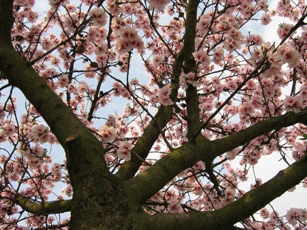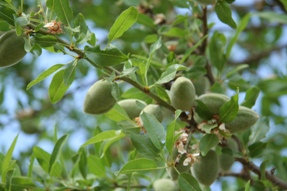Classification

Domain: Eukarya
Kingdom: Plantae
Phylum: Magnoliophyta
Class: Magnoliopsida
Order: Rosales
Family: Rosaceae
Genus: Prunus
Species: Prunus dulcis
Classification standards for
Prunus dulcis:
Eukarya- multicellular and contains a
membrane-bound nucleus and organelles
Plantae- photosynthetic, contains a cell
wall made of cellulose, and reproduces sexually through
alternation of generations
Magnoliophyta- angiosperm, vascular, contains seeds, and is sporophyte
dominant in reproduction
Magnoliopsida- dicotyledon(dicot) and
contains net-veined leaves, 3 pollen holes, secondary growth,
vascular bundles in a ring shape, and flowers that grow in 4's
or 5's
Rosales- dicot,
flowering plant that typically contains an edible fruit
Rosaceae- generally a woody-plant,
contains alternate leaves with stipules at the base of leaf
stalks, hermaphroditic flowers pollinated by insects, and a
fruit
Prunus- contains showy, bright
colored flowers, needs well-drained soil, and can sometimes have
fruit and foliage that are toxic
Prunus dulcis-
Prunus dulcis is a tree that grows to a medium height
between 12-14 feet. The tree contains hermaphroditic
flowers which reproduce through pollination by insects.
Prunus dulcis creates a fruit, the almond, which
consists of an edible seed in a shell that is enclosed by a
hull.


Click on the above images to view a general phylogenic tree of
Prunus dulcis and then a more specific phylogeny of the
tree. Prunus dulcis is most closely related to the peach,
plum, and apricot. They all belong to the genus Prunus
and have fruiting bodies on their trees. The fruit of
peach, plum, apricot, and almond are all quite similar in
morpohlogy.
There are many other organisms in the genus of Prunus,
which are not as closely related to the almond, such as cherries
and nectarines, but are still in their genus. The fruit of
cherries and nectarines are not as similar to the almonds as
peaches.

The
closest related organism to the almond is the peach. Other organisms
related to Prunus dulcis are
Raspberries (in family Rosaceae),
Sunflowers ( in class Magnoliopsida) , and even
Dandelions (in class Magnoliopsida) which can grow in the
same fields as the almond tree.
There are even more extensive and in depth lists of species that
are related to
Prunus dulcis.
Where does the almond live?!
